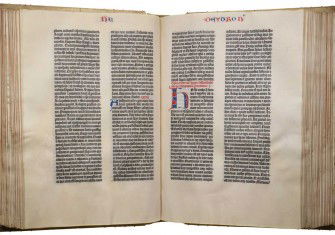Just a Book?
The story of Thomas Jefferson’s bible, his own version of the Gospels.

Ensconced in his Virginia estate, Thomas Jefferson had a secret project. It called for Enlightenment values, biological adhesives and a penknife. For decades Jefferson, the primary drafter of the Declaration of Independence, set his mind to producing another text: his own version of the Gospels.
Jefferson wanted to portray a historical Jesus, not as a divine figure but an exemplary moral teacher. To do so, he studied the Gospels assiduously in English, French, Latin and Greek. The verses he accepted he cut out and glued onto new paper, creating an 84-page book threaded using silk and linen and bound in goatskin. He called the work The Life and Morals of Jesus of Nazareth. It later became known as the Jefferson Bible.
In The Jefferson Bible: A Biography, Peter Manseau tells the story of Jefferson’s idiosyncratic task, placing it within broader scholarship’s search for the Jesus of history. Jefferson hoped to reconcile Christian morality with reason but, as Manseau shows, when the book came to public attention three quarters of a century after his death, his cut-and-paste scripture provoked arguments over the meaning of American democracy.
Born into the colonial gentry, Jefferson rebelled not only against the king but also against his established Church. Classically educated, he read the work of dissenting English theologians who distrusted traditional authority, saw reason as a counterweight to faith and treated scripture as just another antiquarian text. As Jefferson advised his nephew: ‘Read the Bible then, as you would read Livy or Tacitus.’ Referring to Jesus’ central message as ‘a system of the most sublime morality which has ever fallen from the lips of man’, Jefferson tried to extricate the Christ of history from religion.
The Jefferson Bible is more a selection of moral teachings than a narrative. As Manseau writes: ‘He reordered the passages with little regard for the intention with which they were first composed.’ Jefferson’s motivation was personal. Perhaps recalling the fierce controversies of the 1800 presidential election, in many ways a referendum on his piety, he did not try to publish his redacted scripture and seems to have been content to read his Bible nightly, in private.
Lost for decades, the Jefferson Bible was discovered in a private library in 1895. For a nation enamoured with its Founding Fathers, Jefferson’s prized possession became more than a gallery curiosity. In fact, it prompted the sort of conversation Jefferson would have wanted.
Having printed all Jefferson’s other works, the US government resolved to publish it. Advocates saw a pious project and a key to Jeffersonian thought; critics called it an ‘emasculated Bible’ or maintained the state was interfering with the nation’s precious secularity (for which, ironically, Jefferson was heavily responsible). The uproar was so strong that the congressman who proposed publishing the Jefferson Bible was forced to introduce a new bill to block its publication.
As the government baulked, private publishers stepped in – often misprinting the text in the rush to take it to market. In the century and more since, the book has continued to morph. Some editions even reinsert verses Jefferson excluded.
Manseau’s biography is scholarly and witty. It is an excellent introduction to an under-appreciated aspect of Jefferson’s thinking.
The Jefferson Bible: A Biography
Peter Manseau
Princeton University Press 232pp £22
Daniel Rey is the author of ‘Checkmate or Top Trumps: Cuba’s Geopolitical Game of the Century’, runner-up in the 2017 Bodley Head & Financial Times essay prize.





